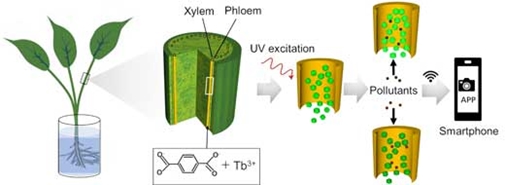|
NOVIDADES
By integrating living systems with functional nanomaterials, nanobiohybrids have emerged to impart organisms with new or bio-augmented properties, such as conductivity, artificial photosynthesis, programmed metabolism and proliferation, or enhanced tolerance against stress. Among them, plants, being ideal candidates for augmentation with other materials due to their vascular network, have been reported to evolve complex signaling to perceive and rapidly respond to environmental variation. Back in 2016, in one of the first 'plant nanobionics' demonstrations, MIT researchers embedded spinach leaves with carbon nanotubes, thereby transforming living spinach plants into sensors that can detect explosives and wirelessly relay that information to a handheld device similar to a smartphone (read more: "Nanobionic spinach plants can detect explosives"). In follow-up work two years later, the team developed nanobionic light-emitting plants that glow by embedding the nanoparticle mixture into the intact plant via root uptake strategies. Inspired by these earlier works, an Australian-Chinese research team demonstrated that photoluminescent metal organic frameworks (MOFs) can be in situ grown inside a living plant (Syngonium podophyllum) without impacting their viability. The MOF-plant nanobiohybrids show selective turn up/down fluorescence signals with even low concentrations (nM∼µM) of pollutants under a simple potable UV lamp excitation. The scientists developed a smartphone app that can read the nanobiohybrids' fluorescence signal output and translate it into digital information. The MOF-plant nanobiohybrids show selective turn up/down fluorescence signals with even low concentrations (nM∼µM) of pollutants under a simple potable UV lamp excitation.  Illustration of MOF-plant nanobiohybrids for environmental pollutants sensing. Reprinted with permission by American Chemical Society
The researchers reported their findings in Environmental Science & Technology ("Metal-Organic Framework-Plant Nanobiohybrids as Living Sensors for On-Site Environmental Pollutants Detection"). By Michael Berger – Michael is author of three books by the Royal Society of Chemistry: Nano-Society: Pushing the Boundaries of Technology NW. Posted: August 19, 2020.
|
|||||||||||||||||||||||||